

|
|
WELCOME TO THE R/C ELECTRONICS TUTORIALS PAGE ON THIS PAGE YOU WILL FIND SOME VERY IN-DEPTH TUTORIALS GOVERNING LITHIUM BATTERIES, BRUSHLESS POWER SYSTEMS, LOW VOLTAGE CUT-OFF DEVICES & BECS AIMED AT THE TRAXXAS EMAXX AND EREVO TRUCKS, THOUGH APPLICABLE TO ANY LARGE R/C TRUCK, TRUGGY OR BUGGY. |
CONTENTS:
1. Lithium Batteries 1. Lithium Batteries
1. What voltage should I use?2. What Mah capacity should I choose? 3. What size will fit? 4. What does the C rating mean? 5. Which brand is best? 6. What run time will I get? 7. What charge current should I use? 8. What about lipo balancing? 9. Can you explain series vs parallel? 10. Can I Waterproof my batteries? 11. What happens if my lipos swell up? 12. Can I use different lipos together? 1. What voltage should I use? In the stock Emaxx and Erevo, the Evx2 is equipped with a pair of battery input leads, each pair intended for use with a 2s lipo (7.4v), giving a total of 4s lipo (16.8v). It is best to use a pair of matching 2s lipos ( that means they must have the same C rating, Mah capacity and be the same brand & age etc ) for space and weight reasons ( a pair of 2s lipos in series will give a total of 4s lipo ) & due to the chassis layout being intended for a pair of packs, rather than one large one: 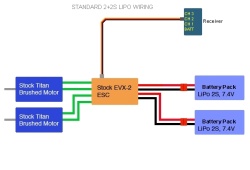 It is entirely possible however to use a single 4s lipo, which may be desirable if you have an aftermarket chassis or have converted a Nitro model to Electric power and have limited room. To do this, you must connect the 4s lipo to the BEC side of the Evx2, and then use a jumper to short circuit the un-used battery input leads. This diagram explains how: 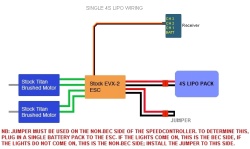
In the Brushless Emaxx and Erevo you can use a maximum of 6s lipo, usually in the form of a matching pair of 2s or 3s lipos. However, many users ( myself included ) find that 5s is the sweet spot for a nice mix of power and speed. To run 5s lipo you merely require a matching 2s and 3s lipo with the same mah capacity & C rating, and of the same brand & age. 2. What mAh capacity should I choose? Capacity is directly linked to runtime- the higher the capacity (measured in milli-amp hours, or Mah) the greater your runtime will be. Lipo cells in general are available upto about 5000mah in capacity, beyond this pairs of cells are used in parallel to increase the mAh, and therefore the runtime. The only downside is that larger mAh cells are also larger in size, and therefore weight (they are still only half the weight of Nimh cells it is worth noting however). Typical lipo packs are sold in 4000,5000,6000 and 8000mAh sized packs, with the optional battery hold-downs being required for the larger sizes. The new Emaxx has more room for lipos compared to the old model, but aftermarket solutions are readily available to allow larger packs to be fitted to either chassis; a velcro strap & dremel can do magical things for your battery options. 3. What size will fit? Since size is linked to capacity, it is worth ensuring that you can actually fit the lipos you wish to use in your truck. The very simple method of doing this is to just measure the length and width of the battery trays, and the height available with whatever hold-downs you have available. A Velcro strap is a simple way to allow taller packs to fit, but you are still limited in regards to length and width, unless you opt for an aftermarket chassis. 4. What does the C rating mean? The C rating is also known as the discharge rating. This is a measure of how much current ( in amps) the battery can output before it will overheat and become damaged. Most lipos have the C rating listed in their specs, but this doesn't actually tell you how many amps the lipo can output, there is a very simple sum however: Mah capacity x C rating / 1000 = output potential ( current ), measured in amps. For example, a 10C 5000mAh pack can output 50amps, and a 20C 4000mAh pack can produce 80amps. This however is assuming that the C rating on the pack is accurate. If you are in doubt, there is fool-proof way of determining the C rating, but it requires additional equipment. Using an Eagletree data logger or similar, you can record the voltage level of a lipo in relation to the amount of current that is being drawn from it. If the voltage level remains at about 3.2-3.4v or higher per cell at the specified discharge ( C ) rate in amps, then it is accurate. If not, then it is over-rated. An example of this would be a 20C 5000mAh pack outputting 100amps and staying at about 3.2v per cell. The graphs can sometimes be hard to interpret, but if you have the current and voltage graphs on the same chart, you can easily locate the voltage at any given current output. One important thing to consider when choosing a pack based on its C rating vs mAh capacity is that ( for example ) 10C packs will drop their voltage heavily when taxed to more than about 12-15C (the typical peak or burst rating of 10C packs). A 25C pack will happily deliver in excess of 35-40C bursts before its voltage output drops, so dont always assume a 10C 8000mAh pack will be just as good as a 25C 5000mah pack in a high-drain application; that would be a false economy. For low drain set ups however where runtime is more important than current output, you would be fine with the lower spec, higher capacity pack. As a rough guide for which specifications to look for when choosing a lipo, the brushed Emaxx and Erevo need lipos capable of producing about 80 to 100amps, so 20C 5000mAh packs or 25C 4500mAh packs would be quite suitable. The Brushless Emaxx and Erevo ( and Savage Flux for that matter ) require lipos capable of producing atleast 120amps, so 25C 5000mAh packs would be a good minimum spec to look for, but you would be much better off with 30C 5000mAh packs or greater; the more overhead you allow in the ratings the less stressed the packs will be during use, so the longer they will live for before they start to lose performance. 5. Which brand is best? There are many lipo brands, several of which use the same specific company/factory to produce their lipos for them, the only differences being the capacity and discharge rating options for any given lipo- horses for courses ( meaning certain lipos are offered to fullfill a certain need or application, hence the differences between any given pair of lipos from two different manufacturers ). The top name to look out for is Hyperion. They are a Korean outfit producing the best quality cells that are used by numerous companies, such as those from RC LIPOS; the latest Hyperion G3 packs are receiving rave reviews, and with good reason. Kokam lipos are also very popular, as are the UK based Flightpower and Trakpower lipos. Next on my list would be the increasingly popular HobbyKing lipos, that come in a myriad of shapes, sizes and capacities to suit most people's desires. SPC lipos give great results for a reasonable price, and the Blue Lipo & Gens Ace branded packs from Hobbypartz are also very popular for the budget minded user. Maxamps lipos are very popular, but mainly due to the fact they advertise so much & essentially bank-roll several R/C magazines with their advertising revenue; they do make lipo selection easy for beginners, but the price point is considerably higher than it should be compared to other & better brands with a similar or greater spec; their latest lipos touted as being 150C have been tested by independent 3rd parties and found to only perform as 30C with approximately 50C burst ratings- best avoided unless you aren't concerned about being ripped off ( Maxamps = bad, for the short of attention ). A full list of lipo retailers and trusted brands can be found on the Useful links page- scroll down the the Battery Retailers section. 6. What run time will I get? Run time is also directly related to Mah capacity. Generally speaking, your typical 8000mAh setup will run for approximately 40-60 minutes in a stock Emaxx, and around half that in a BL setup- 5000mAh will last for about 30 minutes in a brushed Emaxx or Erevo & 15-20 minutes in a BL truck. It is very difficult to estimate runtime however as it depends greatly on the setup, terrain, ambient temps and driving style/ throttle usage; a full on speed machine will drain packs much quicker than a trail truck type setup. 7. What charge current should I use? Lipos require a special type of charger that uses the CC/CV method (Constant Current/ Constant Voltage). Provided your charger is capable, you will be best served using a 1C charge meaning you charge the pack at 1x its capacity. A 5000mah pack will be charged at 5amps, an 8000mah pack at 8amps, and a 4700mah pack at 4.7amps etc etc. Some manufacturers will claim a 2C or even 5C charge rate is possible for their lipos, but I would always recommend a 1C for safety reasons unless the instructions specifically state this; a 2C charge rate for a 5000mah lipo would be 10amps. A123 cells or LiFePo4 can be charged at upto a 4-5c rate safely since they have a more stable chemistry. Charging at a lower than 1C rate is perfectly safe and will not damage any battery type ( some chargers are limited in terms of current output, so simply select the highest setting possible provided it does not exceed the lipos rating ). Please refer to the Tutorial section on Chargers and charging for more detailed charging info. 8. What about lipo balancing? Lipo packs made up of more than one cell in series will require balancing. Lipo cells, no matter how good, will sometimes vary in terms of their exact capacity and discharge rates in relation to the other cell(s) in their pack, so it is important that any imbalance between cells is equalized during or after charging to prevent possible damage due to over discharging or over charging even. Where as a normal charger will pump current into the pack as a whole, only stopping when the target voltage is achieved, a balancer (or balance charger) will read the individual cell voltages and bleed off excess voltage/current from any cell that is getting ahead of its companions. The amount of current a balancer can drain varies, but around 300-500mah is fairly typical, meaning that small imbalances can be fixed during a charge, but larger imbalances may require longer to correct before all the cells are at an equal level of voltage & the charge can be terminated. The fully charged voltage of a lipo cell is 4.2v, so any higher than that and damage may occur; any lower than about 2.6~2.8v and damage will also occur; 3.0~3.2v is seen as the ideal minimum voltage before a lipo cell should be stopped from discharging. Storing lipos for long periods without use or cycling (discharge and charge) them may result in the cells becoming partially drained and out of balance, so checking them occasionally is recommended. Unlike Nimhs though, they do not need to be re-peaked or topped up if they haven't been used for a few days, as lipos do not self discharge any where near as quickly due to lower internal resistance and superior chemistry. 9. Can you explain series vs parallel? Lipos wired in series (+ to - ) will increase the total voltage of a pack. For example, two 2s lipos wired in series will create a 4s lipo. The mah capacity & C ( discharge ) rating will remain the same. Lipos wired in parallel (+ to +, - to -) will increase the total mah available, For example, two 2s 5000mAh lipos in parallel will create a 2s 10,000mAh lipo. The voltage & C rating remains the same. The 's' after 2s for example means Series, and is how many cells are wired in series within that pack (it does not stand for cells). The 'p' after 2s2p for example is how many cells are wired in parallel within that pack (if any). A 2s2p pack has four cells in total, with 2 pairs of cells wired in series to create a pair of 2s lipos, then they are wired in parallel to double the mah capacity. This is why some lipo packs in the 6000-8000mah range are often 2s2p or 4s2p packs which are rather large in size; see below for a diagram showing the basic principle of Series vs Parallel arranged cells ( click each picture for full size ): 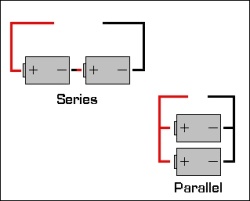 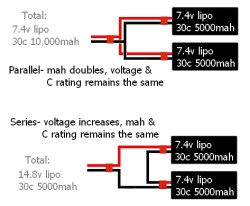 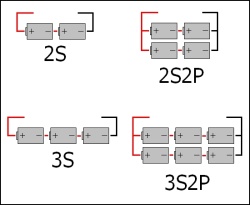 When using batteries in series, the voltage of each pack can vary, but the mah capacity and C rating must be the same on both lipos (the age and condition too ideally). When using them in parallel, the the voltage, capacity and C rating must all be equal to prevent damage to the lower spec lipo through over discharge. 10. Can I Waterproof my batteries? Using some silicon sealant on the open ends of lipo packs that are covered in shrink wrap can help (you can sometimes buy them this way), but the main area for concern are the connectors that are not so easily waterproofed. Rusty balance taps will give inaccurate readings and cause issues when it comes to charging and balancing your packs. Best to avoid running lipos in or near water unless you have the initiative or imagination to come up with a solution to this problem; un-lubricated condoms have been used to great affect by some r/c enthusiasts... 11. What happens if my lipos swell up? This is a symptom displayed by lipos that have been over discharged. They will swell up and often become squishy to the touch, but sometimes also 'deflate' once cooled down. The easy way to avoid this is to choose properly spec'd lipos for your application, or to tone down your setup so that the lipos have some headroom in terms of what you are asking of them. Lipos that have only slightly puffed can still be used, bearing in mind the above piece of advice, but lipos that look like balloons afterwards are best either disposed of safely, or returned to the retailer for warranty purposes. Safe disposal is generally considered as immersing the packs into a salty water bath to discharge them down to 0v, thus removing all their energy and potential to cause damage if punctured. 12. Can I use different lipos together? Depends on what you mean by 'different'. When running two lipos in series ( to increase voltage ), you must use lipos with have the same Mah capacity, Discharge rating ( C rating ), and are the same brand & age/condition ( number of cycles- always best to use lipos in pairs and label them ). The voltage/ cell count of each pack can be different so long as they are the same specification- you can run a 2s & 3s lipo in series for 5s total, for example ( only with an esc which can handle 5s ofcourse- the stock EVX2 esc will only handle a pair of 2s lipos ). When running lipos in parallel to increase mah capacity & runtime, you must use lipos of the same voltage, C rating, mah capacity, brand & age- basically an identical pair. This is because running mismatched cells, either C rating and/or mah capacity will result in the lower spec battery discharging sooner. Since built-in LVC devices only monitor the total voltage of the packs connected and not individual cells, the esc has no way of knowing that some cells may be below 3.0v when the others are still up around 3.6v for example since they still have a fair amount of capacity remaining before they too are discharged. For a quicker bench test using mismatched batteries will not harm the esc or batteries, to check throttle & brakes function correctly say, but prolonged use is strongly recommended against. 2. Brushless power systems
1. Why are Brushless motors/escs better than Brushed ones?2. Why are Lipos so important when using BL? 3. Which brand of motor is best? 4. Which brand of esc is best? 5. What do all the numbers mean on these motors, and what's the difference between 2 pole and 4 pole? 6. Why are 2 pole motors so cheap compared to most other 4 pole motors? 7. What voltage should I use with this motor? 8. Why is high voltage better than lower voltage? 9. Is there such a thing as too much power? 10. Why cant I use the MambaMax or other small 1/10 scale systems in my MT? 11. Can I go BL for cheap? 12. I have more money than sense, what do you recommend? 13. What gearing do I use, what are safe temperature limits? 14. Which type of pinion do I use? 15. Where can I buy all this stuff I need? 16. I can't solder, what should I do? 17. Do I need a different radio? 1. Why are Brushless motors/escs better than Brushed ones? Numerous reasons. BL motors have far fewer parts to wear out, so maintenance is generally just a drop of oil on the bearings every now and then, and perhaps a blast of compressed air to remove any dust or dirt inside the motor. Because of this, your typical BL motor will last for years and years with constant use, where as brushed motors will require their brushes changed and coms skimmed etc etc. 2.Why are Lipos so important when using BL? A BL motor the same size as your typical 550 motor is many times more powerful, but in order to make that power, it needs batteries that can supply it (in the form of high current flow, measured in amps). Nimh batteries are good for about 70amps or so, as I am reliably informed, but large BL setups are much happier with more like 100-150amps typically; if the battery cant keep up with demand, it will rapidly overheat. In the case of nimhs, they explode, and lipos will generally 'puff'; death by over-current in either case. 3. Which brand of motor is best? My personal list would go like this, with attention paid to the size & kv rating of each option in order to choose the most suitable motors for the 4-6s lipo range: NEU-CASTLE MOTORS 1515 2200kv & 1717 (discontinued) NEU MOTORS 1512-1515 in the 1600-2700kv range HOBBYWING MOTORS 4274 2200kv & 4268 2600kv TEAM TEKIN T8 MOTORS T8 Truggy motor in 1700-2250kv range LEOPARD MOTORS 40-44mm x 74-80mm in the 1600-2200kv range LEHNER MOTORS 1950 & 2250 sizes HACKER MOTORS C50 6XL - 11XL FEIGAO MOTORS 36x74 in the 1600-2000kv range Obviously there are many more brands and manufacturers, but those are the main ones you will likely encounter. My personal choice for a high budget build would be Neu, blue or black variety. For a mid range budget, I'd go for the Medusa or Castle motors, and then the Leopard motors for a low budget build. Feigao work fine, but they are prone to running hot and broken magnets are all too common compared to the better brands. Hacker and Lehner are European brands, so you are far less likely to find yourself buying one, plus the prices are somewhat astronomical as they are aimed at high powered aircraft and boats, though they are just as at home in a large truck. I missed PlettenBerg off the list since again, although they really are the best of the best, they cost more than your truck will generally speaking, so only uber rich dudes will find one of those on their shopping list. Buying a motor and esc together as a system will generally be cheaper and makes life easier for the less experienced, but sometimes purchasing them separately is preferred for whatever reason. 4. Which brand of esc is best? This used to be a tough call, but at present the Castle Creations MMM ( Mamba Monster (Max) ) is top dog. It is a great esc, very smooth, great programming options, and very reliable- after sales service is extremely good and waiting times for warranty / non-warranty work is usually 2 to 4 weeks at most. Team Tekin have the RX8 esc, aimed at the same kind of market as the MMM- 1:8 scale truggies and buggies, though it is slightly more expensive as Tekin is a racing team, so racing escs will always be aimed more specifically at racers willing to pay a bit more for what they use. The MGMs are good escs also. They don't have quite the programming options of the MMM, but they do have more options in terms of the voltage & current various models can handle, so there isn't a need to go with just one esc when a cheaper model will do what you require, and then some. That said, they are about twice the price of the MMM for comparable models. Some say they aren't quite as smooth, but the updated software of late is the best yet. Being based in Europe often leads to issues with extended turn-around times on repair work, but they have a fairly good reputation. HobbyWing XE-RUN 150amp & 80amp escs are a relatively new product from China, looking suspiciously similar to the MMM esc. They are much improved however over the older EZ-RUN escs that dwarfed the MMM but had various durability issues- not much cheaper than the MMM & MMPro escs, but certainly one to consider if every penny matters. Beyond that, there are more Chinese escs that are clones of existing American & European designs, most others are either plane/heli items with no proportional brakes or reverse, or are intended for use in much smaller and lighter vehicles. Not that its impossible to use a forwards only esc, but it is best left to the guys doing BL conversions of nitro vehicles that use mechanical brakes. MAMBA MONSTER ESC TEAM TEKIN RX8 ESC HOBBYWING ESC MGM COMPRO ESCS 5. What do all the numbers mean on these motors, and what's the difference between 2 pole and 4 pole? The model numbers on some motors don't necessarily refer to the dimensions of the motor, they are more a simple method of comparing different versions & variants within a manufacturer's range. Lets take a Neu 1515 1Y: 15 = diameter of motor, in this case 39mm with the smooth can. Most BL motors of the 550 variety are 36-44mm in diameter. 15 = length of the magnet/rotor. Other companies will use the second set of digits to denote the length of the can, which is often XL or ~74-80mm for the kind of motors we need in MTs. 1 = number of winds or turns, the fewer there are, the faster the motor is (higher kv rating (rpms/volt)). This also means the motor will draw more current, so beware. Y = type of wind. Motors are either Wye or Delta wound. Wye wound motors generate 1.73 times more torque than their Delta equivalent, but are also 1.73 times slower (1515 1 y = 2200kv, 1515 1 d = 4100kv). Longer motors will generate more torque in general, as will larger diameter ones. Feigao type motors are easiest to understand as they are generally sold as S, L an XL sized cans; anything with a diameter of 36mm or greater being what you are after for MT use. Neu motors however have an advantage as they have 4 poles, vs 2 on the Feigaos. This important as a 4 pole motor will generate almost twice as much torque, all other things being equal, though 2 pole motors will normally spool up a little faster which makes them better for light weight dragster-type models. Of course, you can find motors with more than 4 poles quite easily, with some Inrunners ( rotor inside the coils ) having 6 or 8 poles, and many outrunners ( rotor outside the coils ) having 16 or more poles- outrunners aren't normally used in ground based models though as they do not spin fast enough, they are designed for spinning propellers usually. KV is a term you will see used often, and it refers to the number of RPMs per volt that a motor will spin; the higher the kv rating, the faster it will spin, but the more current it will draw too. 6. Why are 2 pole motors so cheap compared to most other 4 pole motors? Feigaos are cheap Chinese copies of Hacker motors. They are both 2 pole motors, but the quality and efficiency is much higher in the German made motors, as is true of the 4 pole American Neus & Tekins etc. Though the power output of most 2 pole motors is adequate, the temperature and magnet issues are an unfortunate side effect; you must watch your gearing far more closely with the lesser motors than with the much more flexible and cooler running better quality brands. As an entry level motor, they are a good place to start, however if you are unsure what set up you are after, but don't be fooled into thinking exotic water cooling solutions are the answer to keep a motor cool- that works in boats, not in trucks. A fan is much more simple, but often just masks the true problem, which is often a poor motor, bad gearing or poor overall setup choices. 7. What voltage should I use with this motor? Although often argued about, I have a very simple set of basic guidelines that can be used as a general guideline for choosing which voltage to run any given motor on: 1900-2700kv = 4s lipo 1700-2200kv = 5s lipo 1500-1900kv = 6s lipo Guidelines only. You can quite happily run a 2200kv motor on 5 or 6s lipo, but unless you gear down you will have a road missile. This sounds fun, but an uncontrollably fast truck can be quite dangerous, trust me; for speed runs only usually. I personally use a 2000kv motor on 5s lipo, and many others use the 2200kv Neus on 4s lipo. There is much potential for debate, but if you want a powerful setup that also runs fairly cool, then the 1900-2200kv range is best for 4-5s lipo. A high kv motor like the 1515 1.5d (2700kv) is best used only for 4s lipo, and a low kv item like the 1515 2.5d for 6s lipo. Since most easily available escs are rated for 6s lipo, this should help make the decision easier, but as always, reading around and researching will yield far more info to aid you. 8. Why is high voltage better than low voltage? There is a very simple equation: Power (watts) = volts x amps An MT requires a certain amount of power in order to move at a desired speed with a certain amount of torque. In order to generate that power level, you either require more amps and less volts, or more volts and less amps. Since current draw is one of the limiting factors with most if not all batteries and escs (not to mention wires and plugs), it is most wise to use a setup that draws less current and therefore more voltage. Obviously there is also a limit to the voltage you can use, but by simply choosing a 6s lipo setup and a slower, less amp hungry motor, rather than a 4s setup, you can make considerable improvements to your temps, runtimes and improve the lifetime of your equipment; repeatedly heating up electronic components will eventually kill them, sooner rather than later. A high voltage setup can be just as fast as a low voltage one, generate the same amount of wheelie-popping power, but will also allow you to often use lower spec batteries for the same given power levels. That said, if you simply increase the voltage without changing the motor, there is a higher load on the motor and batteries, which will reduce your runtime. If you gear down however to the same speed as you were achieving with the lower voltage, then runtime will increase some degree. Obviously there is a monetary issue that cannot be ignored with regards to choosing a higher voltage esc & batteries, but whenever possible, it is a route that should be exploited as it can save you money in the log run. 9. Is there such a thing as too much power? Most would say no, but there is of course. In a 10lb MT, you need a minimum of about 500-800watts to have 'fun', but most setups will be pushing the 900-1300watt region, with much higher peaks (under acceleration). Generally speaking, an XL or 1515 sized motor would be plenty, but for speed runs you might consider a larger 1521 or 1527 motor; these are truelly giants, but if you want to exceed the ~70mph world record for an Emaxx (HPI cheated with their touring car Wheelieking, bunch of goits), then you will need a lot of motor to do it. 10. Why can't I use the MambaMax or other small 1/10 scale systems in my MT? As it says on the CastleCreations website, the MambaMax system is designed for use in 2WD 1/10 stadium trucks, such as the Traxxas Rustler, Stampede and Bandit sized models. The Emaxx and Erevo are nearly twice the weight, and 4WD, which places too great a load on the little CC36 motors. The same is true of the Traxxas Velineon/ VXL systems, only those are limited to 3s lipo, making them a far from ideal choice; the only saving grace is that they use a slightly larger motor than the MM system, but still not big enough really. Likewise, there are many small 35-60amp 2-3s lipo capable esc on the market these days that are only suitable for small 1/10 models; don't be fooled if you think an emaxx or similar MT is a 1/10 model- that is just a technicality. If your model weighs over about 5lbs, then you need true 1/8 scale electronics. 11. Can I go BL for cheap? Yes, but.... A cheap & pretty reliable setup would be one of the HobbyKing 150amp escs, a feigao 9XL or similar 2 pole motor, and a pair of 30-40C 5000mah 2s lipos from HobbyKing ( the motor being the weaker link which can always be upgraded later on ). That should come in under about $300-350 for everything you need pretty much; if that is still too expensive then either save up longer or reconsider your model choice as the larger the model is, the more expensive it is to power. 12. I have more money than sense, what do you recommend? A Plettenberg BigMaxximum motor, 6s lipo, MMM esc. Hold onto your hat... 13. What gearing do I use, what are safe temperature limits? Gearing is made easy thanks to that nice bloke Brian Gosselin ( BrianG ): TOPSPEED CALCULATOR Assuming you are wanting a fun, controllable setup, aim for 40mph with your setup. There are options everything you need to input such as differential ratios, transmission ratios, tire size, voltage, and specific motors. If your motor isn't listed, you should know its kv rating however, so you can enter it manually, same too with your tire diameter and anything else such as spur gear size etc. All the options for Traxxas vehicles and feigao/neu motors are listed, so it shouldn't be too hard to figure out. For a speed machine, a top speed of about 60-65mph is a realistic target, but it is easy to get carried away with the numbers you punch in, so remain sensible and be realistic about what your setup can do. A ~2000kv feigao on 4s lipo isn't going to exceed 40mph without temperature issues; bumping up the gearing will only make this worse, as will using more voltage. Excessive heat on a motor is very bad news, and as a general rule, you shouldn't exceed 180F, or about 150F on the esc, and 120-130F on the lipos. This should be helpful as a general guide to gearing and temps: Hot motor + cool esc and batts = undergeared. Cool motor + hot esc and batts = over geared. Hot everything = way overgeared. Warm everything = correctly geared. The Emaxx 3908 ( BL emaxx ) comes with stock gearing of 18/68 & the BL Erevo comes with stock gearing of 18/65 which is intended for use with 12/14 nimh cells ( such as the batts provided with the truck ) and gives a top speed of around 32mph. When using 4s lipo you will need/ want to increase the gearing to around 24/68-65 which gives a top speed of 38-40mph. With 5s lipo 24/68-65 gives around 48-50mph top speed, and with 6s lipo the same gearing gives 58-60mph. These are ideal gear ratios for each voltage though you do have room to gear a little higher or lower depending on the temps you get. A realistic maximum speed of about 65-70mph is possible with 6s lipo and the stock 2200kv motor, however much attention must be given to the tire choice, suspension ride height and stiffness, lipo choice and general aerodynamics to avoid the truck becoming airborne or suffering a blow out. Below is a screen shot of the gearing calculator with a worked example of the options you should choose to arrive at a good setup for 4s lipo use ( click to view full size ): 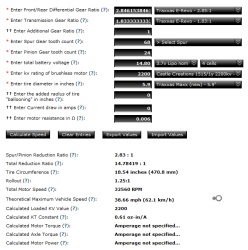
14. Where can I buy all this stuff I need? Head over to the 'Useful links' page and you will find extensive links to numerous online retailers. Broadly speaking, besides the esc, motor and batts, you will require connectors for the motor to the esc (3 male and female bullet plugs, 5mm or larger), battery plugs of your choice, and some 10-12 gauge wire. As I'm biased, RC-Monster is a great place to get most things, but larger retailers like TowerHobbies and AmainHobbies also have most items. Shop around though, as many of the smaller boat and plane/heli web-stores also carry the items you require, often at lower prices with more variety- many of these smaller stores are listed on the Useful Links page. 15. What type of pinion do I use? Since the Emaxx and Erevo use 32pitch, or MOD 0.8 spurs ( same thing ), you require a 32pitch pinion (the difference between 32p and MOD0.8 is so small that they are interchangeable). Motors with a 5mm shaft will require 5mm bore pinions (that's most BL motors intended for 1/8 scale use), motors with a 3.2mm or 1/8" shaft will require pinions with the same sized bore (bore meaning the hole in the middle). It is ill advised to simply drill out a pinion to increase its bore size, as this can cause it to spin off center, making a stripped spur or broken shaft more likely. MOD 1 pinions are most often used on nitro conversions, though they can also be used on purely electric vehicles when an especially small tooth count is required often, or when the user has issues with stripping the smaller teeth on 32p pinions. When mounting the motor, make sure the screws are not too long and do not touch the windings inside the motor. Also make sure that the mesh is not too tight, as this can cause binding that will heat up the electronics rapidly due to the high load place on the motor to spin the gears. A piece of thick paper placed between the spur and pinion before they are pressed together (meshed) will give just the right amount of clearance. If you cant feed paper in between them as you rotate the gears by hand, the mesh is to tight; if the paper goes in all to easily, the mesh is too loose. A tiny amount of backlash or play is what you are looking for, but it is important this remains the same as you rotate the gears, to ensure spur gear doesn't bind with the pinion at any point in its rotation. 16. I can't solder, what should I do? Learn. All you need to know really in order to solder is that you need a hot iron ( 60-80watts is more than fine, but 40watts is just about enough to do most things too, but takes a little longer- for soldering larger bullets & Deans connectors I would recommend at least a 60watt iron though ), keep it clean with a damp sponge or brillo pad (you can buy special tip tinner and cleaner too), and use good quality lead free solder. Extra flux helps, but is often corrosive so be careful. When soldering things like deans plugs, be careful as holding the iron in place too long can cause the plastic housing to melt; soldering most connections should only take a second or two, to get in there and out again. If you visit Youtube, there are many great tutorials showing how to solder, and how useful tips and info on selecting the right iron etc, so do yourself a favour and study them; in this game, it's pretty much essential knowledge. 17. Do I need a different radio? Maybe, depending on what you currently have. AM radios and BL motors simply don't mix 99% of the time, there is too much RF (Radio Frequency) interference generated by the motor and it's wires. An FM radio (like I used to use) will yield much better results, but even that glitches occasionally & has a limited range. The best upgrade is a digital 2.4 Gigahertz item. I cant speak for which brand is best, but as always, (you've guessed it) read around. 3. Low voltage cutoffs
1. What is an LVC, do I need one?2. Which LVC should I buy? 3. Do I need one for each battery? 4. What if there isn't one for my voltage lipos? 5. How do I connect an LVC? 6. Can I use it with Nimhs or A123 batteries? 7. Where do I get one? 1. What is an LVC, do I need one? Low Voltage Cutoff, sometimes referred to as A Low Voltage Device or Detector ( LVD ). It is a device that is connected between the esc and throttle channel on the receiver (rx), and also connects to the power wires of the lipo battery. When it detects the voltage has dropped below a certain level, it alters the throttle signal and prevents the esc from running the motor, thus preventing the lipos from discharging further. Different LVCs work in different ways however; some kill the throttle altogether, some reduce the throttle power (known as soft shutdown or cutoff), whilst others are merely buzzers or flashing LED systems which connect only to the battery/ batteries to warn the user that their batteries are running low- these versions do not interrupt the throttle signal. Either way, when the LVC begins to kick in, you should stop running the truck. It is also best practice to stop running the truck when you notice the power and speed of the truck has noticeably reduced- do not rely solely on the LVC, use your own judgement too; this is known as using 'The Force'... Whether or not you need one depends on the ESC in your model; if you have an older, brushed model, chances are it doesn't have an LVC built in- you need to refer to your models user manual, if you have one, or check the manufacturers website. If your model is a Brushless one, then chances are you already have one built in and simply need to learn how to set it up, assuming it isn’t automatically set up when turning on the esc each time ( calculates number of lipo cells and requires no user input ). As always, RTFM. If by some chance your esc doesn’t have an LVC built in and you require a separate one, read on… 2. Which LVC should I buy? This depends on a couple things: Does your esc have dual battery inputs or just a single + and - lead? Do you trust my advice more than that of other people? Point being that the Evx2 and HvMaxx type escs (older models with no LVC built in) use a pair of 2s lipos, but each esc has two pairs of input leads to the esc. Now, these type of escs generally use one input lead/lipo to also power the BEC (Battery Eliminator Circuit- powers the escs brain and the servos/rx), so one lipo will always discharge slightly faster than the other. If using an lvc that monitors the total voltage, it can be fooled into thinking that both lipos are still in the safe voltage zone, for example: One 2s lipo is at 5v, the other is at 7v = 12v total, but one lipo has cells that are at only 2.5v each, which is dangerously low. To prevent this kind of issue, my personal advice is to run a single 2s LVC on the lipo that also powers the BEC, there by preventing either lipo from discharging below the safe voltage level ( widely accepted as 3.2v per cell ). The BEC side of the esc can be found by plugging in a single 2s lipo to the esc; the side that activates the esc but wont run the motors is the BEC side- the non-BEC side will do nothing with a single lipo pack plugged into it. Please note that this advice only applies to the Traxxas EVX2 and now defunct Novak HvMaxx esc. 3. Do I need one for each battery? No, but it doesn't hurt in terms of having redundancy. 4. What if there isn't one for my voltage lipos? Highly unlikely. Since the stock EVX2 esc on the traxxas brushed E-maxx & Erevo only accepts one 2s lipo per battery input, you shouldn't normally have need for a higher voltage model of LVC. All the same though, most BL escs operating in the 4s lipo and higher region will have built in LVCs, such as the MambaMonster ( MMM ) and HobbyWing BL escs. However, occasionally you may want to use a separate lvc on your lipo, so an LVC which works with 2-6s lipo will be perfect as it isn't reliant upon the number of cells connected in order to operate. A 6s model which connects to the lipo's balance plug will have 7 pins ( one negative and six positive usually ), simply insert the LVC into the balance plug, observing correct polarity- any unused pins will sit beside the connector and are perfectly fine. The best solution is an LVC that monitors individual cell voltages in real time and gives off a warning if any one of the cells dips below the LVC threshold, but these are few and far between at the present time: Hobbyking 1-6s voltage checkers & Monitors 5. How do I connect an LVC? Quite simple usually with minimal or no soldering required. Depending upon the LVC itself it either plugs in between the esc and throttle channel on the rx, and then there is normally a + and - wire which go to the power input wires of the esc ( battery leads ). This is where you have a few different options ( see diagrams below also ): 1) If you are using a dual battery input esc such as the EVX2, then use a 2s LVC & wire it to the battery input leads which also powers the esc's built-in BEC. 2) If you are using a single battery or esc with a single battery input, then wire the LVC to the the esc side of the battery plugs/connectors. 3) You can avoid soldering directly to the esc wires by making a shunt-type in-line connector between the esc & lipo, known fondly as the Kraegar harness 4) If you are using a stand-alone/ passive lipo monitor, you can plug it into one of the lipo's balance connectors. NB: It is strongly recommended to use a matching pair of 2s lipos with the EVX / EVX2 esc, therefore a 2s LVC device is recommended & is preferable- use the first diagram below as a guide for connecting up a 2s Novak Smartstop LVC, or the last diagram for a stand-alone 2s LVC device. Most simpler LVCs will use a balance connector rather than the + and - wires, so this plugs into the lipo's balance connector to monitor the total voltage or individual cell voltages; its manual will be more specific and include it's own wiring diagrams. Below are a few possible LVC setups using various escs & battery configurations: 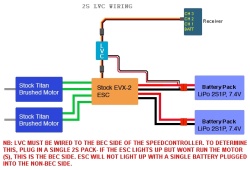
Wiring for the 2s version of the Novak Smartstop LVC. 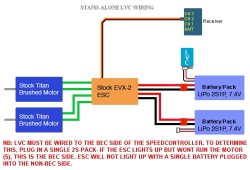
Hook up procedure for a stand-alone LVC monitor-type device. Ideal for wiring-free LVC installation & having adjustable LVC options ( 3.2-3.4v per cell is fine ). It is important to reiterate that most of these are considered as 'passive' devices, meaning that they won't stop the truck from running, but instead just warn the user when their lipos are becoming discharged. An audible alarm is generally better than a visual one, but it depends on how good your hearing, eyesight, and common-sense quotient is. It is also worth pointing out that since stand alone LVCs do not have any connection to the esc or receiver, it is entirely possible to use one on each lipo in order to be fully protected against over-discharge. Simply plug the alarm into the balance connector coming from the lipo pack, observing correct polarity, and it will emit a loud high-pitch noise when the lipo cells drop below a preset voltage threshold; some models are adjustable, some are not, but most have their threshold set at 3.2-3.3v per cell and this is deemed perfectly adequate- 3.4v is becoming the favoured norm. 6. Can I use it with Nimhs or A123 / LiFePo4 batteries? Not required for Nimhs, and A123 type cells operate at a different voltage to lipos, 3.3/3.65v per cell rather than 3.7/4.2v per cell. This means the LVC will kick in much too soon. Ordinarily though, you don't need an LVC with A123 cells as when they reach the nearly discharged point, they drop in voltage very quickly, meaning you notice the lack of power and can stop the truck. Also worth noting that A123s are much more tolerant to over discharging and fast charging compared to lipos, but that is covered more in the Emaxx & Erevo FAQs if you care to read further. 7. Where do I get one? Most online retailers such as Amainhobbies and TowerHobbies will carry LVCs, but it is probably quicker & easier to simply refer to the Useful Links page. 4. Lipo Chargers & Charging 2. How does a lipo charger work? 3. How long does it take to charge a lipo? 4. How do I charge my Lipo ( aka: Lipo charging for Dummies )? 5. Can I charge more than one lipo at once? 6. How do I choose a Power supply for my charger? 7. Can I build my own powersupply? 8. Where do I buy the balancing adapter for my lipo? 9. My lipo wont charge, what do I do? 10. How do I charge A123s/ LifePo4 batteries? 11. How do I charge Nimhs? 12. Im a n00b, which charger should I buy? 13. Can you also recommend a dual or multiple lipo charger? 14. How should I store my lipos if I don't plan to use them for a while? 15. What Should I do with a swollen or damaged lipo? 1. What is a lipo charger? A lipo charger is battery charger that is specifically designed to charge lithium polymer ( Lipo ) cells intended for R/C use. You cannot use a regular nicad or nimh charger to charge lipo batteries as they use different charging methods. 2. How does a lipo charger work? Lipo cells have a voltage of 4.20v when fully charged, but require a special charging method know as CC/CV ( Constant Current/Constant Voltage ) in order to squeeze every last ounce of current ( measured in amps- 1amp = 1000 mah ) into the cells. The first phase of the charge ( CC ) is the same as is used to charge nimh and nicad batteries, where by the charger supplies a steady flow of current into the cells until they reach approximately 4.20v. During this phase the charger occasionally drops the charge current to see if the cells are holding their voltage- as they begin to fill up the voltage they hold will increase, and so the voltage the charger supplies will decrease. Once the cells are holding close to their maximum rated voltage the charger switches to the second phase of the charge ( CV ) where it will supply a steady voltage to the cells, but gradually reduce the current, checking every so often to see if the cells are holding their voltage. This will continue until all the cells are holding 4.20v ( give or take 0.02v ) and then the charge will finish. During the charge the charger will also remove excess voltage from any cells that are above the level of the other cells, in order to keep them balanced & charging at the same rate; this is known as balancing. Balancing is done via the charger of it has a built-in balancer ( this is where the small white connector on the lipo plugs into ), or via a separate balancing device which also plugs into the lipo's balance plug. It is always best to balance-charge lipos if your charger is capable. 3. How long does it take to charge a lipo? This depends on a number of factors. Firstly, it depends on how quickly the label on your lipo says it can be charged- this is expressed as a C rating ( similar but separate to the discharge C rating ), where 1C is equal to the pack's mah capacity. For example, a 5000mah lipo cell with a charge rating of 1C can be charged at 5amps, which will result in a charge time of one hour; the same cell with a 2C charge rating can be charged at 10amps which will result in a 30 minute charge time etc etc. The second factor which affects the charge time is how powerful your charger is, which is expressed in watts ( the total power rating of the charge circuit ) and in amps ( how much current the charge circuit can output, regardless of total power rating ). Firstly you must determine the total power rating of your lipo pack in watts, this is very simple thankfully. You must multiply the number of cells by their fully charged voltage, and then by their mah capacity divided by 1000, eg:- 2s lipo x 4.2v = 8.4v, x 5000mah / 1000 = 42 watts. 4s lipo x 4.2v = 16.8v, x 5000mah / 1000 = 84watts. Now, assuming you stick to a 1C charge rate ( if in doubt, always use 1C ), and your charger has a power rating of 50watts, you can work out how long it will take to achieve a full charge by dividing lipo's wattage by the charger's wattage, eg:- 42watts / 50 watts = 0.84 hours, or approx 50 minutes. Since you are only using a 1C charge rate however and not maxing out the charger, the charge will take 1 hour. 84watts / 50watts = 1.68 hours, or approx 100 minutes. Since you require more power than the charger can supply/ handle to achieve a 1C charge rate, the charger is forced to reduce the charge current, resulting in a longer charge time & a charge rate of less than 1C. This does not harm the lipo as lipos are not sensitive to the charge current unlike nimhs and nicads, you will not lose any punch or peak voltage; when a lipo is full, it is full- there is nothing to gain from re-peaking a lipo in an effort to gain extra performance. The more powerful the battery ( more cells, higher mah capacity ), the longer it will take to charge with a low power charger. The higher the Charge rating of the lipo, the faster you can charge it provided the charger and power-supply is capable of supply the required current and wattage; if the charger is limited to 5amps, you cannot charge a 5000mah lipo any faster than 1C. If you have an 8000mah lipo on a 5amp charger, you can still charge the lipo just fine- it will just take longer as the charge current is lower than the rated capacity of the lipo. 4. How do I charge my Lipo ( aka: Lipo charging for Dummies )? Okay, so you have your lipo charger ( and PSU if a separate one is required ), charging leads, balancer board that matches your lipo's balance connector ( unless the charger has the balancer sockets built-into it's side ), and you have your shiny new lipos. First thing to do is inspect the lipos and connectors to make sure the polarity is correct on all items ( red is positive, black is negative ) & to check for any loose solder joints- a poor electrical connection will cause errors during charging & will result in terrible performance for the vehicle if there is high resistance in the connection between battery & esc. 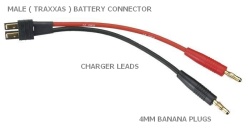 Next we need to connect the charger leads to the charger, observing correct polarity- most chargers use 4mm sockets on the charger, and 4mm banana jacks on the charge leads, with a male battery connector on the other end. 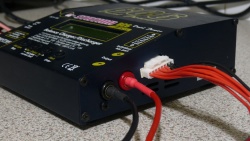 Now we go ahead and plug the main battery connector into the charge lead- do not be alarmed if there is a small spark, this is perfectly normal & is just the capacitors inside the charger charging up instantly from the battery ( same happens when connecting the batteries to your esc- the higher the voltage, the bigger the spark ). 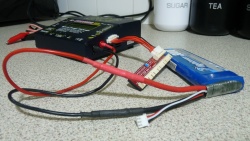 The next step is to connect the smaller white ( sometimes black ) balancer plug on the lipo into the balancer board or port on the charger. As most boards are designed to accept 2s lipos upto 6s lipos or higher, just match the size of the plug to the correct socket, or count the number of pins on the balancer connector and match it to a socket or 3. How long does it take to charge a lipo?port with the same number of pins. The connector will only go in one way around, so it should be impossible to connect it wrongly without excessively forcing the connectors together. 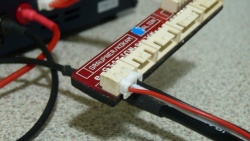 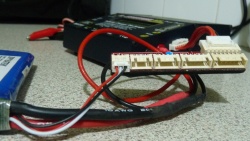 We now need to turn on the charger, and enter the correct settings for your lipo pack. As all chargers vary to some extent the menu screens, options & names may not be identical but entering the correct settings is very straight forward as you work through each menu screen: 1) Set the battery type to LIPO  2) Set the charge type to BALANCE CHARGE ( this is where some chargers vary- some will balance automatically if the balancer lead is connected so setting the mode to CHARGE is fine, others like my old Bantamn BC6 charger will only balance charge lipos if you set them to BALANCE mode. Refer to your charger manual to understand exactly how each charging mode works ).  3a) Set the number of cells to match your lipo pack ( 2s, 3s, 4s etc ), or set the voltage to match your pack- most chargers will use multiples the nominal voltage so 2s = 7.4v, 3s = 11.1v, 4s = 14.8v etc etc. 3b) Set the charge current to match your lipo pack's mah rating, eg; 5amps = 5000mah, 4.5amps = 4500mah, 3.3amps = 3.3amps etc etc. If your charger does no allow small adjustments in 100mah increments, set the charge current as close as possible without going over the pack's current rating ( so 3amps is fine for a 3300mah pack, but 4amps is too much ordinarily ). If your lipo's capacity is higher than your charger's maximum charge current, don't worry- just set the maximum charge current possible & the charger will still charge the pack fully; it will just take a little longer. If your charger is powerful enough, and your lipo packs can accept a higher charge rate ( 2C or 5C charge for example, where 2C is twice the current, 5C is 5 times the current ) then you can adjust the charge current to a higher level as desired- just bear in mind many lower-end basic chargers have a 5-6amp charge current limit, and higher charge rates will ultimately shorten the life-span of the lipo pack.  4) When you are happy you have set the charger correctly, go ahead and hit the START button ( you may have to press it for a couple seconds like mine ); some chargers will start charging straight away, others ( like mine ) will display the number of cells you have entered and ask you to confirm by pressing the start button again. If the voltage or number of cells the charger displays ( auto-detect feature ) is incorrect, go back and make sure you entered the cell count / voltage correctly. Sometimes when lipos have been discharged ( through use or other means ) the resting voltage is a little low and the charger sees the pack as having one less cell than it really does- it is simple to resolve this issue however, please refer to section 4.9 for instructions.  5) Now the lipo is charging, you can monitor its progress by using the arrow keys on the charger to cycle through the different display screens. Not all chargers are alike, but most will be able to display the total voltage of the pack, the voltage of each cell, & the present charge current & input voltage. As the cells begin to get full the charge current will drop, until eventually it is almost zero amps & the cells are balanced; some cells may lag behind others or race ahead during the charge, but by the end they should all read 4.20v, give or take ~0.02v per cell.   6) If your charger times out and stops the charge before the pack is fully charged, you may need to enter the menu to increase the safety cut-off timer, and maybe also increase the maximum capacity limit to slightly higher than your pack's actual capacity ( since the rated capacity is rarely 100% accurate- some packs hold slightly more or less capacity, as much as ~500mah extra has been noted before ).   To avoid any potential for fire caused by a faulty lipo or charger, the lipo packs should be placed inside a fire-proof bag or container during the the charge ( and for storage too ). These are easily purchased from most good hobby stores or online hobby retailers, coming in various sizes to suit any manner of different sized lipo packs. Once your packs are charged and the cells are well balanced, they are ready to use straight away without needing to wait for them to cool down, unlike many nimh or nicad packs. It must be noted that packs should not be left fully charged for longer than 2-3 days, or a week at the most as high voltage levels will degrade the anode & cathode material inside the pack, leading to poorer performance & reduced capacity further into the pack's lifespan. See section 4.14 for storage instructions. 5. Can I charge more than one lipo at once? Technically speaking you can, but this depends on how powerful your charger is- it may not be worth the effort if you only have a low powered charger as you may require more wattage and amps to charge both lipos together than the charger can supply; this is especially true if you have a pair of 2s 5000mah lipos and only a 50watt charger. I would simply suggest purchasing another inexpensive charger ( it's less than 50 dollars for a basic 50watt charger usually ), or upgrading to a multi-channel charger ( please refer to section 13 for more information ). 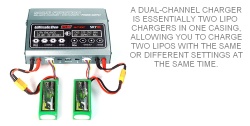 6. How do I choose a Power supply for my charger? I'm going to assume you don't have a mains powered charger ( AC/DC ) for this question, since those chargers have a built-in power supply and are generally limited to 50watts though there are some slightly more powerful AC/DC models around. Choosing the specification you require is the simple part, choosing the brand can be more difficult and this is where research comes in handy- google is a very powerful tool for tracking down opinions on any given charger or power supply. The first thing to remember is that most power supplies ( PSU ) are around 80-90% efficient, meaning that you should choose a model that is slightly more powerful than your charger or will not get the maximum charge rate out of your charger, and it may also shut down as the PSU struggles to supply as much current or voltage as the charger is demanding. So, for a 200watt charger, you would want a 250watt PSU ideally, perhaps even 300watts depending on price and features. The features you are looking for depends on how many chargers you want to run from it ( so a PSU with 2 sets of outlets would be needed to run 2 chargers ), and whether you need the ability to regulate the voltage and maybe current the PSU is supplying. Some higher end model PSUs have digital or analogue displays on the front to show you in real time how much power the charger is pulling. Some high end chargers will not output their maximum charge current / power rating unless they are supplied with higher voltage levels; many chargers are happy with ~12-14v, some need more like 16-18v- this will usually be noted in their specs or features information however. For some recommendations and suggestions, see below: UK based options: Fusion 200 watt 15 amp Racing Star 230 watt 17amp adjustable Etronix 350 watt 25 amp Fusion 600 watt 40 amp adjustable International options: Junsi P350 350 watt 23 amp PRC350 350 watt 25 amp PRC500 500 watt 33 amp You may note I haven't linked to any Hobbyking otpions; it seems a few people are having issues with their PSUs from Hobbyking, compared to their chargers which are pretty much rock solid, so I recommend checking out the options from ProgressiveRC linked above. 7. Can I build my own Power supply? Yes. There are numerous tutorials around which show you how to turn a PC PSU into a PSU suitable for powering an r/c battery charger. My favourite two tutorials deal with a regular PC PSU, and a much larger and more powerful server-type PSU:- Cheap 12v PSU modification How to build a $27 47amp PSU 8. Where do I buy the balancing adapter for my lipo? Most Lipo brands these days have settled on the common JST-XH style of balance connector, but occasionally you may come across a different style. Firstly you must workout what style of balancing adapter your lipo has, to do that refer to my handy chart below ( click to view full size ): 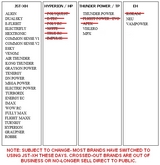
The exact adapter you need will depend on the brand & model of charger you buy; Hyperion chargers for example have their own style of port on the side of the charger into which various different adapter boards plug into; you can usually find all the styles of board on the ALLRC.com website and the PROGRESSIVE RC website, otherwise checkout the website where you are buying the charger to see if they sell adapter boards for the different styles of balancing connectors. You will find many chargers these days have ports in the side which will accommodate 2-6s lipo balance connectors of the JST-XH style without the need for an adapter board at all. A quick google search for the type of adapter you require usually turns up some good results too ( such as JST-XH to TP adapter ). 9. My lipo wont charge, what do I do? I'll assume you've set the battery type, charge current & cell count/ voltage correctly. If the charger gives you an error message along the lines of 'voltage too low' or only recognises your 4s lipo as a 3s for example, there is a very simple solution. What's happening is that the lipo cells have discharged below a certain voltage threshold that the charger wants to see in order to correctly calculate the number of cells in the lipo you have hooked up- as a rule this is about 3.2-3.3v per cell, but may vary. What you need to do is put the charger into NIMH mode, set the same charge current you normally would use for the lipo, disconnect the balance connector, and then start the charge. Give the lipo about 10-15 minutes and then stop the charge and restart it in LIPO mode with the balancer reconnected and the appropriate settings applied; the charger should hopefully recognize the correct number of cells and charge like normal. If not, give the lipo another 5-10 minutes in NIMH mode and try again. This is assuming that the lipo or it's wiring isnt damaged in any way, otherwise you will never get the charger to recognize the correct cell count. At this point you would need to open up the shrink wrap over the lipo and inspect the solder joints for any breakages, and repair them if needed. 10. How do I charge A123s/ LiFepo4 batteries? You must use a charger that is capable of charging these types of battery for starters, though most modern Lipo chargers have a setting ( charge profile ) for them; A123s and LiFe ( LiFepo4 ) cells are the same chemistry and voltage, they just have different form factors ( meaning A123s have a cylindrical metal casing where as LiFe have a soft foil casing ). They should be charged in much the same way as Lipo batteries, but they sometimes don't have a balance connector ( usually home made A123 packs ), and they have a different resting/ nominal voltage ( 3.3v ) and different voltage when fully charged ( 3.6v-3.7v per cell, precise voltage can vary with different cells and chargers, but you should not use a charge setting that charges the cells above 3.7v no matter what ). Other than that, they behave much the same as Lipos. 11. How do I charge nimhs? Nimh & Nicad cells behave differently when charged depending on how quickly you charge them. If you give them a slow charge of less than 1C, then you will gain a longer runtime but with less 'punch'. If you use a faster charge rate of around 1C, they will have greater punch when freshly charged, but the runtime will be shorter. On the charger, select the appropriate cell type and set the charge rate to suit your needs, but do not exceed 1C, then hot the start button- the charger will automatically detect the number of cells and stop the charge once they are fully. If you have a modern charger then it will use the 'peak sensing' method of determining when the cells are full by sensing the point at which the cell voltage begins to drop as it forces in current. Unfortunately this isnt an exact science so the charger can stop early sometimes, resulting in what's known as a 'false-peak'; you can tell when this has happened because the battery will still be cool. As a rule, the battery should only be 'quite warm' when the charge has completed, it should not be hot and it should not be still cool- hot indicates over charging. Depending on the features the charger has you may be able to adjust the exact voltage as which the charger terminates the charge, this is usually referred to as the 'mV' setting and can be raised or lowered to adjust the charger's sensitivity- refer to the manual for precise instructions on altering this setting. 12. I'm a n00b, which charger should I buy? I get this question a lot, hence why I'm writing this new Charger section for the Tutorials page. Well, this depends on a number of things; how much do you want to spend, how quickly do you want/need to charge your lipos, do you want a simple mains powered charger, do you need a charger you can use in the field, do you want to charge 2 lipos at once etc etc. If you just want a cheap, reliable charger that can be powered from the mains and you are never in a rush to charge the batts, then I have the perfect solution for you: USA: Sky Charger AC6 UK: Core RC UAC50 Charger 12v/110-240v 6A These are very simple to operate, inexpensive chargers which can charge all battery types, have a built in power-supply so can be powered via the mains or a 12v external PSU, have a built-in balancer and come with a selection of charge leads; not bad for 50 dollars or 60 quid. The only thing really lacking is that they only come with a limited selection of charge leads, where as most people will require either a deans or traxxas ( trx ) connector to suit their batteries. Again there is a very simple solution, several actually for that matter. You can either buy a replacement charge lead with a suitable connector, simply type 'deans charge lead' or 'traxxas charge lead' into Google or Ebay and you will get plenty of suitable results ( 99.9% of chargers use 4mm bannana jack connectors for the other end of the lead, so no issues with compatibility should occur ). Or, you can cut off the old tamiya style connector and solder on a male version of whichever brand your batteries use- again, ebay of google will return plenty of results by searching for 'deans connector', 'traxxas connector' etc etc. You can also buy adapter harnesses which have all the major types of connectors on the end, a quick search for 'squid charge lead' or 'multiple charge lead' should turn up a few results. If you would prefer something more powerful but still want a charger that only charges one lipo, there are many, many options. Calculate how powerful your charger needs to be for how large & how fast you want to charge your lipos, and then have a look through these various options ( this is just a small sample of whats out there ) which range from low to high in price: Turnigy Accucel-6 50W 6A lipo charger w/ accessories IMAX B6 lipo charger 1-6 Cells Turnigy Accucel-8 150W 7A lipo charger Thunder AC680 80W 6A 6s lipo charger iCharger 106B+ 250W 6s lipo charger HYPERION EOS720I NET 3 AC/DC 90W/150W LIPO CHARGER 7S Thunder 620 300 watt 20 amp 6s DC lipo charger Thunder 0620AC 300 watt 20 amp 6s AC/DC lipo charger Turnigy Reaktor 1000 watt 30 amp 10s DC lipo charger iCharger 206B 300W 20A 6s lipo charger iCharger 1010B+ 300W 10A 10s lipo charger iCharger 306B 1000W 10A 6s lipo charger UK based options: Etronix PowerPal Touch 100W 10A 6S AC/DC lipo charger HTRC C150 150W 10A 6S AC/DC lipo charger Overlander VSR-Mini 60W 6A 4S AC lipo charger Overlander 80W 10A 6S AC/DC lipo charger Etronix Powerpal 80W 10A 6S AC/DC lipo charger Core-RC UAC50 50W 6A 6S AC/DC lipo charger It's worth mentioning at this point that there are many companies which simply re-brand cheap Chinese OEM chargers and raise the price in order to make a great profit- companies such as Orion and Venom are well known for doing this, along with many others. For that reason, it pays to shop around and compare prices & specifications before making a final selection. 13. Can you also recommend a dual or multiple lipo charger? Sure thing numpty. As you will have seen with the more powerful single lipo chargers, most dual lipo chargers are also powered a separate PSU, though there are an ever increasing number of mains powered ones around which makes life easier. Below is a partial list of dual and quad channel lipo chargers since there a lot of them around these days, which is nice: Turnigy Quad Lipo Charger 4x 100W 10A 6S Turnigy Reaktor Lipo Charger 2x300W 20A 6S TURNIGY REAKTOR 2X300W 30A SkyRC Ultimate Duo 400W 20A 6S HYPERION EOS 0720i NET3 CHARGER 2 X 7S 20A MAX 500W Turnigy Reaktor Quadkore 4x300W 20A 6S FMA GT500 8S 500W 20A UK based options: SkyRC D100 AC/DC 100W 10A 6S SkyRC D250 2x120W 10A 6S SkyRC D400 400W 20A 7S Etronix PowerPal Touch Duo 100W Fusion L712BP Emperor 2x500W 20A 7S lipo charger SkyRC Q200 200W Abisma CTC Duo Touch 14. How should I store my lipos if I don't plan to use them for a while? Ideally if you don't plan to use your lipos for several weeks or months, they should be charged or discharged to about 50% capacity- most modern chargers have a 'storage charge' setting which will charge the lipos to around 3.8v per cell. They can then be safely stored away in a safe place until needed; it is said storing lipos in the fridge can prolong their life span, though if you are married this may not be a good idea... You should also check on the condition and voltage of the lipos occasionally to make sure they haven't puffed during storage, you can also identify any weak cells as they will have dropped to a lower voltage faster than the others in the pack. Storing lipos fully charged can cause the anode and cathode material to corrode inside the cells resulting in poorer performance; you should never store lipos fully discharged ( below 3.0v per cell ) either as this may result in them becoming over discharged eventually, at which point they are likely to puff or become difficult to recharge in the future. 15. What should I do with a swollen or damaged lipo? If only one cell is swollen or damaged it is entirely possible to remove that cell and reconfigure the pack, such as turning a 6s lipo into a 5s lipo for example. You would simply need to identify the bad cell and disconnect it from the pack, then bridge the gap in the circuit and adjust the sequence of the balancing wires on the connector to remove the gap ( assuming it isnt the last cell which goes bad, in which case there is no need ). If however the majority of the cells have swollen up ( puffed ) then you will need to cut off the power and balance wires ( save those ) and place the lipo into a bowel of salty water for several days to completely discharge the pack down to 0 volts. You can then dispose of the lipo as per your local recycling laws. 5. BECs ( Battery Eliminator Circuit ) 2. When / Why do I need one? 3. How do I connect it up? 4. What specification do I need? 5. Where can I get one? 6. Are there any other options besides a BEC, or to complement a BEC? 1. What is a BEC? In the olden days before modern Electronic speed controls, we had Mechanical speed controls that were essentially a variable resistor attached to a servo, which opened & closed the throttle much like a servo does on a nitro or petrol/gas powered model. However, due to the very basic nature of these controllers there was no way to power the servos when the main running battery ran out of juice ( resulting in the throttle staying at it's last position, often full throttle which had the potential to be very dangerous ), so a smaller secondary battery was required to power the servos still, much like a nitro or petrol powered model that has no main running battery. With the advent of ESCs there was no need for a separate battery to power the servos, as the speed controller has a small circuit inside that diverts some of the power from the main battery(ies) in order to power the servos and receiver. This what the BEC is & does, it steps down the voltage of the main batteries to something more useful such as 6 volts, and is able to supply upto 3amps or so typically. There are two types of BEC, Linear & Switching. Linear BECs work much like a voltage regulator and do not produce much electrical 'noise' ( which can cause radio interference ), but they are also inefficient so get quite hot during use- not good news inside a small confined plastic cased ESC. Switching BECs or voltage regulators are much more efficient at stepping down the voltage and do not get as hot, but they can be quite large and do produce more electrical noise, so they work best in models fitted with a 2.4ghz radio system. There are however limitations to how much voltage and current ( amps ) an internal BEC like this can provide, and it is possible to overload them with too many servos, or servos which draw too much current; newer generation high voltage servos also require more voltage to operate properly than an internal BEC can provide ( ~6v & 1.5-3amps being the normal maximum output ). This is when an external BEC is required... 2. When / Why do I need one? As above, when you have so many servos, or such powerful servos connected that they draw too much current and overload the ESCs internal BEC, you need to upgrade to a more powerful external BEC. You can tell when the internal BEC is being overloaded as the model will either lose control or stop working momentarily, especially when you are working the steering hard from side to side; this is known as a 'brown out'.brimg src= The throttle will either start working again once you stop working the steering, or the ESC will reset itself and then start working again. 3. How do I connect it up? There are several ways to wire up an external BEC, depending on whether you just need more power ( amps ) for standard ( voltage ) servos, or if you need more voltage for HV servos. Since most receivers ( RX ) only operate at 6v, it is not safe to try and power HV servos through the RX as it may be damaged by the excessive voltage. The most common way to hook up an external BEC is to plug it directly into a spare slot on the RX ( any unused slot is fine, such as the BATT/AUX slot ), and then disable the ESC's internal BEC by either removing the small red wire from it's RX lead, or using a short extension with the red wire removed. Do not set the CC BEC higher than 6 volts when plugged directly into the RX as damage may occur ( click images to view full size ): 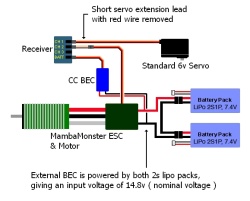 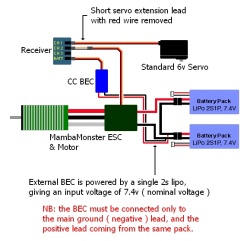 The other main method of hooking up an external BEC is somewhat more complex, but still fairly straight forward if you follow the diagram. Here, the ESC's internal BEC still powers the RX, but that is all- the servo gets it's power directly from the external BEC, with only the small signal wire from the servo connected to the RX so that you can still control it. Do not set the CC BEC higher than the maximum voltage the servo can withstand when powering it directly as damage may occur ( click images to view full size ): 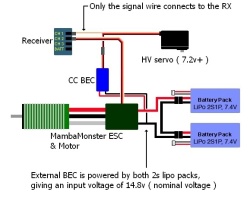 As you can see in both cases, the BEC is always powered by one or both of the main running batteries; it is strongly recommended to use Lipo or LiFe batteries as these do not suffer from voltage-droop during use as badly as nimh & nicad batteries do, especially in high-load situations ( power hungry r/c truck for example ). 4. What specification do I need, can you recommend me a model? This depends upon the nature of the servo(s) that you are running, but a current output of at least 5amps is needed ideally to cope with powerful digital servos. Voltage wise, this depends on whether you are running standard 6v servos, or a HV servo requiring anything from 7.2v upto 3s lipo ( 11.1v ) to operate at it's maximum rated performance levels. Typically, many external BECs are limited to 3-5amps & fixed at 6v, though some have a small jumper plug or switch that allows you to swap between a 5v and 6v output voltage ( quite why you'd want a 5v output is another question though ). The most popular model currently is the CastleCreations BEC ( CC BEC ), or the BEC Pro version for guys running HV 1/5 scale models; the smaller blue model will suit 99% of people's needs however as it can accept upto 6s lipo input ( 25.2v fully charged ) and outputs upto 10 amps & 4.8 - 9v volts ( output voltage is set at 6v, a CastleLink is required to adjust it higher or lower ). 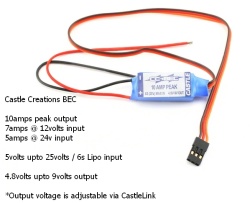 5. Where can I get one? You can order CC BECs from several sources- most good online hobby stores should have them along with larger brick & mortar hobby stores: CastleCreations.com TowerHobbies.com AmainHobbies.com There are also various other external BECs which have a suitable specification for typical r/c truck use: Align 6A 5.1/6Volt external BEC Turnigy 5V 8A 2-3S BEC WesternRobotics Hercules 5a 4.4/5.3/6/8.3Volt external BEC Turnigy 5A 5V HV Input Switching voltage regulator Turnigy 5a 5/6Volt Switching BEC 6. Are there any other options besides a BEC, or to complement a BEC? If you have a HV servo, it is possible to run it directly from a small 2s ( 7.4v ) lipo, however you will also need to wire up some form of Low Voltage Cutoff or Alarm to prevent the lipo itself from over-discharging; this can result in a very messy wiring set up, especially if you are tight for space on your model's chassis. A voltage regulator does the same job as a BEC to reduce the input voltage down to something more useful, but typical Linear step-down regulators generate a lot of heat as they are less efficient than a more modern Switching regulator or BEC. Overall, a switching BEC is the best option to run powerful digital servos or extra electrical items such as LEDs if the ESC's built-in BEC cannot cope with the current draw. That said, sometimes the ESC just needs a little help to prevent brown-outs and a BEC may not be required, instead you can just fit what is known as a Glitch-buster capacitor ( or voltage protector ). These are essentially a small capacitor that plugs into a spare slot on the RX and can provide extra current when you are working the steering hard, preventing the voltage from drooping too low at the same time, thus stopping the internal BEC from being overloaded and causing the esc to cut out or reset. These require no wiring and just plug straight in, and they are very simple to make yourself if you have basic soldering skills- simply purchase a radial capacitor rated for ~2000-4000uf 12v low-esr 105C and solder a servo pig-tail ( connector and leads ) to the legs, then insulate the exposed joints ( and cut away the unused yellow/white signal wire ). 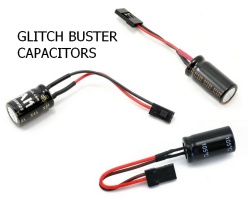 |